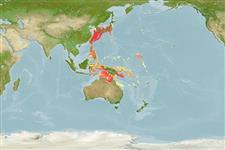sub class Elasmobranchii (ฉลามและกระเบน) (sharks and rays) >
Carcharhiniformes (Ground sharks) >
Triakidae (Houndsharks) > Galeorhininae
Etymology: Hemitriakis: hemi-, from hemisys (Gr.), half, being a genus that Herre believed was “most closely related” to Triakis. (See ETYFish); japanica: -ica (L.), belonging to: Japan, type locality. (See ETYFish).
More on authors: Müller & Henle.
Environment: milieu / climate zone / depth range / distribution range
นิเวศวิทยา
เกี่ยวกับทะเล,น้ำเค็ม สัตว์น้ำหน้าดิน; ระดับความลึก 20 - 345 m (Ref. 86942). Subtropical; 40°N - 19°N, 112°E - 141°E
Northwest Pacific: China, Taiwan, Korea, and Japan. Nominal records from Ambon, Indonesia (unconfirmed and based on a specimen close to if not identical to Hemitriakis abdita) and New Caledonia (Ref. 13563).
Length at first maturity / ขนาด / น้ำหนัก / Age
Maturity: Lm 91.5, range 81 - 102 cm
Max length : 110 cm TL เพศผู้/กระเทย; (Ref. 244); 120.0 cm TL (female); อายุสูงสุดที่ได้รายงาน: 15 ปี (Ref. 9031)
Occurs close inshore and offshore down to at least 100 m depth. Presumably feeds on small fishes, cephalopods and crustaceans. Ovoviviparous, with 8 to 22 young in a litter. Size at birth about 20 to 21 cm. Utilized for human consumption.
Ovoviviparous, embryos feed solely on yolk (Ref. 50449).
Compagno, L.J.V., 1984. FAO Species Catalogue. Vol. 4. Sharks of the world. An annotated and illustrated catalogue of shark species known to date. Part 2 - Carcharhiniformes. FAO Fish. Synop. 125(4/2):251-655. Rome: FAO. (Ref. 244)
IUCN Red List Status (Ref. 130435)
Threat to humans
Harmless
Human uses
การประมง: การค้า
เครื่องมือ
Special reports
Download XML
แหล่งที่มาจากอินเตอร์เน็ต
Estimates based on models
Preferred temperature (Ref.
123201): 9.7 - 27, mean 20.2 °C (based on 252 cells).
Phylogenetic diversity index (Ref.
82804): PD
50 = 0.5156 [Uniqueness, from 0.5 = low to 2.0 = high].
Bayesian length-weight: a=0.00427 (0.00183 - 0.00992), b=3.04 (2.83 - 3.25), in cm total length, based on LWR estimates for this (Sub)family-body shape (Ref.
93245).
ระดับชั้นอาหาร (Ref.
69278): 4.4 ±0.4 se; based on diet studies.
ความสามารถในการกลับคืนสู่ปกติ (Ref.
120179): ต่ำมาก, เวลาต่ำสุดที่จะทำให้ประชากรเพิ่มขึ้นเป็น 2 เท่าใช้เวลามากกว่า 14 ปี (Fec=8).
Fishing Vulnerability (Ref.
59153): High to very high vulnerability (72 of 100).
